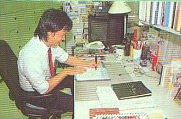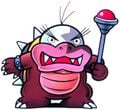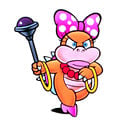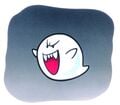Super Mario Bros. 3
This article is under construction. Therefore, please excuse its informal appearance while it is being worked on. We hope to have it completed sometime soon.
Template:Articleabout Template:Infobox
Super Mario Bros. 3 (also known by the abbreviation SMB3) is a platform adventure game for the Nintendo Entertainment System. It was released in Japan on October 28, 1988; in North America on February 12, 1990; and in Europe on August 29, 1991. It was later released in the US on the Wii's Virtual Console on November 5, 2007. It is the sequel to Japanese version of Super Mario Bros. 2, although outside of Japan, it is considered the sequel to the Americanized Super Mario Bros. 2.
It has been considered as one of the greatest games of all time. Its complexity and challenging levels made it a huge success. In addition to new power ups, it featured new moves, items, and enemies. It also features special non-level parts of each world, including Toad Houses and Spade Panels, as well as some secret parts, such as the White Toad House and the Treasure Ship. Shortly after the release of the game, a cartoon named The Adventures of Super Mario Bros. 3 was made. The cartoon was based on the game, except the plot was changed. In the cartoons, King Koopa and his Koopalings tried to take over the real world as well, and not only the Mushroom Kingdom.
Story
Bowser has returned to the Mushroom Kingdom and now with the help of his seven Koopaling children, he tries to conquer it again. He sends his Koopalings into seven parts of the Mushroom World to capture the king of that area, steal their magic wands and with the wands, alter the kings' appearance. Princess Toadstool sent Mario and Luigi to go and stop the Koopalings and turn the kings back into their normal form. At the end of each world, Mario and Luigi fought one of the Koopalings, and after the match was over, the brothers took the wand from the Koopaling and turned the king back to normal. While the brothers are out in their adventure, Bowser kidnaps Princess Toadstool and takes her to his castle in Dark Land. The brothers go to Dark Land and fight Bowser. After defeating Bowser, they save Princess Toadstool and they all return to the Mushroom Kingdom.
Worlds
Grass Land
The first world of the game, that was attacked by Larry Koopa, who stole the Magic Wand of the Grass Land King and turned him into a dog. The landscape itself is mainly composed of plains, surrounded by hills and even some cliffs in the south. A fortress can be found in the middle of Grass Land, and the king's palace lies to the southeast, surrounded by a circular moat. The enemies Mario encounters here are regular ones, like Goombas, Koopa Troopas and Piranha Plants. The world features a Spade Panel, two Toad Houses and six levels, of which four have to be cleared to reach the king's palace.
Desert Land

A land that is also called Desert Hill. It is a region within a vast desert, filled with sand, palm trees and some pyramids. A fortress is located in the west part of the desert, and a quicksand field can also be found, as well as a great pyramid that the player needs to traverse in order to reach the kings palace. The king was attacked by Morton Koopa Jr., who turned him into a spider. The world features two Spade Panels and three Toad Houses, of which one lies in a secret area behind a rock, that needs to be crushed by a Hammer. It contains a Warp Whistle. Four of the five levels need to be cleared to get to the great pyramid and the palace. Desert land houses many desert-related creatures like Fire Snakes and the Angry Sun.
Water Land
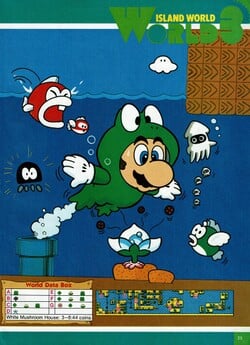
Also refered to as Ocean Side, this world is a water themed region that was raided by Wendy O. Koopa. While some levels take place on solid ground, most of the levels and even one of the worlds two fortresses involve water in a certain way. At the northern part of the worldmap, Mario will encounter drawbridges that open and close in a set pattern. The worlds palace is located far to the east on a small remote island that is only accessible through a Warp Pipe. The king of Water Land was turned into a Kappa during Wendy's attack. A boat can be unlocked by using a Hammer on a rock in the south. Through it, the player can reach some bonus Spade Panels and Toad Houses. Water Land contains nine levels in total, of which one can be skipped if a certain drawbridge is closed, and houses several water creatures like Bloopers, Cheep Cheeps, and Big Berthas.
Giant Land
This world, which is also known as Big Island, is mainly composed of an island in the vague shape of a Koopa. It is a relatively green island with plants growing on it that resemble Fire Flowers. The castle at the west coast of the island was attacked by Iggy Koopa who transformed the Giant Land King into an Acrocanthosaurus. The world has two fortresses, one on the eastside and one on a small island in a lake in the world's center. The most prominent feature of Giant Land, which gives this world it's name, is the fact that many enlarged versions of regular enemies can be found here. The world features four Toad Houses, two Spade Panels and six levels, of which five need to be cleared to reach the king's palace.
Sky Land

The area known as Skyland is the land that has been conquered by Roy Koopa the Koopaling. It is divided into two parts: A ground part and a sky part. The player begins on the ground. The most notably feature of this area is the possibility to gain the Kuribo's Shoe, an Item that can be obtained in level 5-3. After clearing the levels on the ground, the player can reach a spiraling tower that reaches up to the sky. The main part of the level is located here, and there are also some creatures exclusively to this realm, namely the Fire Chomp and the Para-Beetle. After clearing the tower that serves as a link between the two areas, the player can go back to the ground, but they will have to clear the tower again on their way up. If Roy Koopa isn't defeated at the first try, his Airship will be able to move freely between sky and ground. There are 9 levels in total, 3 Spade Panels, 3 Toad Houses and 2 Fortresses. The palace is on the southwest part of the sky part.
Ice Land

Sometimes referred to as Iced Land, this land is an area covered in snow and ice. The palace of Ice Land was attacked by Lemmy Koopa and Mario has to venture there and reclaim the Magic Wand just like in the previous worlds. Before he can reach the palace however, the player has to navigate Mario through the levels of Ice Land. These levels feature frozen ground which makes movement more difficult, as Mario has poor footing on them and is likely to slip off into a bottomless pit. In some levels, the player can find ice blocks that contain coins or enemies. These blocks can only be melted with one of Fire Mario's Fireballs. There are 10 levels in total, 3 Spade Panals, 2 Toad Houses, and 3 fortresses. the Palace is far to the east near the sea.
Pipe Land
More commonly knowned as Pipe Maze, Pipe Land is a series of small islands in a network of confusing pipes. The 4th stage is an underwater level with spiked Cheep Cheeps, some Big Berthas and 3 Blooper Nannies. Prince Ludwig von Koopa attacked the Pipe Maze king and turned him into a goldenrod Venus Fire Trap. The country itself consists of 9 levels, 3 Spade Panels, 2 Fortress, 2 Special Nipper Levels and 3 Toad Houses. The palace is located in southeastern Pipe Maze by the sea. If not slain, Ludwig von's airship will fly from one island to another, since the anchor is required to stop him.
Dark Land
Castle of Koopa (World 8) Ruled by Bowser. The Japanese version of the game spells Koopa as Kuppa.
Warp Zone (World 9)
Warp Zone is only accessible by a Warp Whistle. In the Warp Zone, the player can choose to go to any other world in the game. The selection of Worlds the player can choose from, changes depending on the World he/she used the Warp Whistle in.
World-e
(e-Reader-based world; exclusive to Super Mario Advance 4)
Power-Ups
| Small Mario | File:Small Mario SMB3.PNG | This is Mario's weakest form, but it is the standard form used whenever a new game starts. If Mario is in one of his upgraded forms and takes too much damage, he will return to this state. While in this state, if Mario takes damage once, he will lose a life. |
| Super Mario | File:Super Mario SMB3.PNG | This is Mario in his full size after using a Super Mushroom. Mario gains the ability to break Brick Blocks in this state (which he will not lose even if upgraded further), and additionally he can take one extra hit before losing a life. |
| Fire Mario | File:Fire Mario SMB3.PNG | After utilizing a Fire Flower — no mater which form he is currently in — Mario will turn into Fire Mario, giving him the ability to throw fireballs at enemies. |
| Invincible Mario | File:RainbowMario.gif | After getting a Star, Mario will become invincible, being unable to be harmed by any enemies and most obstacles, (with the exception of abysses and getting squished. |
| Raccoon Mario | File:Raccoon Mario SMB3.PNG | After using the Super Leaf, Mario will transform into Raccoon Mario. In this state, Mario can spin his tail to attack, and he can also fly for a short period of time after gaining enough speed. |
| Hammer Mario | File:Hammer Mario SMB3.PNG | After gaining the Hammer Suit, Mario will turn into Hammer Mario. In this state, Mario can shield himself with his shell and throw hammers. However, Mario cannot slide down hills. |
| Frog Mario | File:Frog Mario SMB3.PNG | Mario will turn into Frog Mario after retrieving the Frog Suit. The Frog Suit allows Mario to swim much easier, but impedes his movement on land drastically. |
| Tanooki Mario | File:Tanooki Mario SMB3.PNG | While wearing the Tanooki Suit, Mario turns into an advanced Raccoon Mario. Along with the abilities to fly and attack with his tail, Mario can turn into a statue to confuse his enemies. |
| Kuribo Mario | File:Kuribo Mario SMB3.PNG | Only obtainable from a Goomba in World 5-3 of the game, the Kuribo's Shoe allows Mario to safely hop across dangerous objects and jump on spiky enemies, such as Piranha Plants and Spinies. |
After the player obtains a power-up that is greater than a Super Mushroom, they can take an additional hit from an enemy or object before returning to their Super form.
Enemies
Goombas
Koopas
Buzzies
Piranha Plants
Lakitu
Hammer Brothers
Fortress
Water
- Cheep Cheep
- Baby Cheep
- Big Bertha
- Bloober
- Bloober Nanny
- Boss Bass
- Jelectro
- Lava Lotus
- Spiny Cheep-Cheep
- Deep-Cheep
Artillery
Bosses
Fire
2-Player
In two-player mode, player one is Mario, and player two is Luigi. After one bro. completes a level/loses a life, the other bro. plays. Also, if one bro. picks a level that the other bro. completed, they enter a battle stage similar to Mario Bros.
Glitches
(For a full list see List of Glitches)
- In World 3-6, Mario is temporarily unable to break a block when he is in his raccoon form.
- In any Mushroom House on any world map, if the player is Fire Mario while shooting fireballs, they are green, when they leave, the color returns to normal.
Development
This article is under construction. Therefore, please excuse its informal appearance while it is being worked on. We hope to have it completed as soon as possible.
Following the poor critical reception of Super Mario Bros. 2, Nintendo had to make a sequel that was stronger than its predecessor.[1] The hard part of creating a video game with old characters is making the old characters seem fresh and new.[2]
Remakes
- Super Mario All-Stars
Super Mario Bros. 3 was later revamped and included in Super Mario All-Stars, with updated graphics and sound for the Super Nintendo Entertainment System. A notable addition to the All-Stars version was a save feature. Additionally, there's a Battle Game feature that works differently from the ones featured from the maps in the 2-Player Game Mode.
- Super Mario Advance 4
In 2003, the fourth entry in the Super Mario Advance series, Super Mario Advance 4: Super Mario Bros. 3 was released for the Game Boy Advance. It boasted similar graphics and sound to the All-Stars version, and made use of the e-Reader. A few e-cards came included with new copies of the game, while two sets (referred to as "series") of cards, were released and sold alongside the game. By scanning special cards into the e-Reader, players were able to upload items, videos, and most importantly, new levels into game. One notable item was the Cape Feather from Super Mario World, which allowed Mario to transform in Cape Mario. There were also two Switch cards that the player could activate (and deactivate) the effects of by scanning them; the Orange Switch and the Blue Green Switch. Scanning these switches triggered small functions in the game. The e-Reader feature is absent in the European version.
- For a complete listing of cards, see Super Mario Advance 4 e-Cards.
References to Other Games
- Mario Bros.- There is a multiplayer mini-game very similar to this game.
- Super Mario Bros.- When Toadstool is saved from Bowser she says "Thank you Mario, but our Princess is in another castle hehe, just kidding!" this is a reference to the Mushroom Reatainer's line "Thank you Mario, but our Princess is in another castle!" from this game.
- Super Mario Bros. 2- Toadstool's appearance is identical to how she appeared in this game.
- The Legend of Zelda- The warp whistle is an item taken from this game.
References in Later Games
- Super Mario World- The sunken ghost ship is speculated to have once been one of the invading Airships.
- Super Mario All-Stars- This contains a remake of Super Mario Bros. 3.
- Super Mario All-Stars + Super Mario World- This contains a remake of Super Mario Bros. 3 and the sunken ghost ship is speculated to have once been one of the invading Airships.
- Tetris DS- Levels 4, 5 and 6 on marathon mode show Mario identical as how he appears here running through levels found here on the top screen. Also a remix of the Over World Theme plays.
- Dance Dance Revolution: Mario Mix- Music from SMB3 is remixed in this game.
- WarioWare: Twisted!- Mario as he appears here, is features in a SMB3 style Micro-Game.
- Super Smash Bros. Melee- Main Over World Theme was remixed in both Mushroom Kingdom and Princess Peach's Castle.
- Super Smash Bros. Brawl- Main Over World Theme from Melee reappeared.
- New Super Mario Bros.- Many concepts started in here are features in this game, such as Toad Houses.
- Defend Your Castle- By clicking SMB3W4 with the Wii Remote in the special thanks section leads to a game with giant stick men. SMB3W4 actually means Super Mario Bros. 3 World 4, which was Giant Land, hence the giant stick men.
- Mario Kart Wii- A license plate which reads "SMB3" can be found.
- Super Mario Galaxy- Level 1-2 and Airship Music were remixed in this game.
- Super Mario Galaxy 2- Another enlarged world appears, a possible homage to Giant Land.
Official Artwork
For more artwork, see this game's Gallery.
Mario
- RaccoonMarioFly.jpg
- Fire Mario SMB3.jpg
Fire Mario (color scheme in remakes)
- Frogs.jpg
- SMB3 TanookiMario.jpg
- SMB3 HammerMario.jpg
Other Characters
- Peach Toad Luigi SMB3.jpg
Princess Toadstool, Toad and Luigi
Transformed Mushroom King
Bosses
- SMB3 Bowser.jpg
- Larry koopa.PNG
Enemies
- BOMB!.jpg
- ChompArt.jpg
Scenes
Trivia
- The movie The Wizard had new footage of Super Mario Bros. 3. The game was played at a video game competition, and was supposed to not be released in stores yet, but, somehow, Jimmy's (the "Wizard"'s) friends knew of the secret of the Warp Whistle in the first world.
- This game was ported into the American arcade machine, Nintendo Playchoice-10.
- There is a way to remove Bowser's fire powers, rendering him useless as a Fireless Bowser.
- The back of some boxes show an unused level.
- This marked the first appearance of the Koopalings and the Boo species.
- This is both sale wise and chronologically the first time Mario has fought Bowser's children as Wendy O. Koopa says this is the first time she has fought Mario.
- A Toad Suit was planned to be in the game but was scrapped for unknown reasons.
- The NES version of the game was released twice in English. In the re-release, the names of the worlds were changed to (theme of world) Land, while the first English version used the Japanese names. Other changes include a slightly different set of instructions from Toad's N-Spade game and a slight rewrite in one of Toadstool's letters, changing "Kuribo's Shoe" to "Goomba's Shoe".
- In the Scholastic World Book of Records for 2007, this was the best selling game.Template:Fact
- The NES version of the game was placed 5th in the 100th issue of Nintendo Power's "100 best Nintendo games of all time" in 1997.[3]
- Super Mario Bros. 3 paper can be found in the Animal Crossing series.
References
External links
- Program Details for Super Mario Bros. 3 - Time Attack
- Nintendo Power Special: The making of Super Mario Bros. 3
- The Lost Levels in Super Mario Bros. 3

